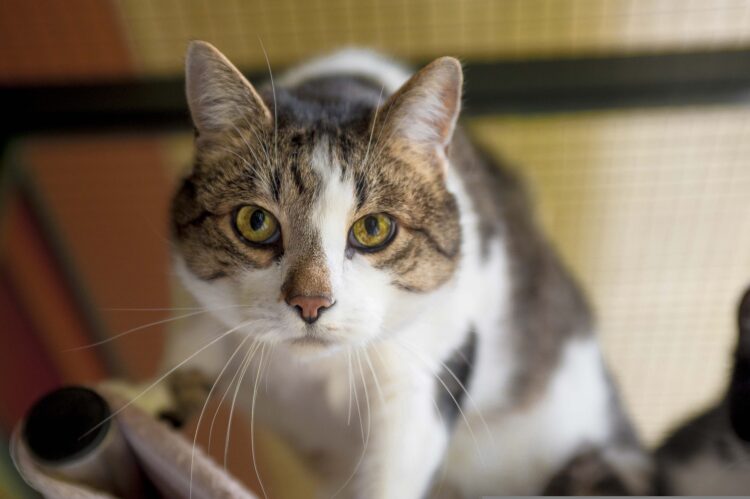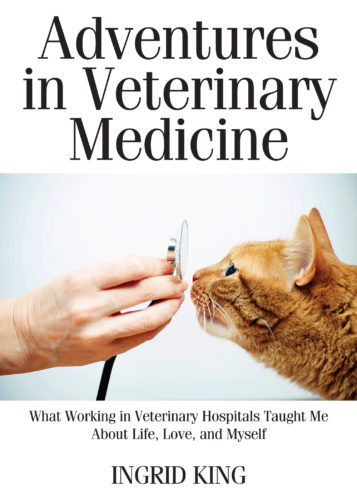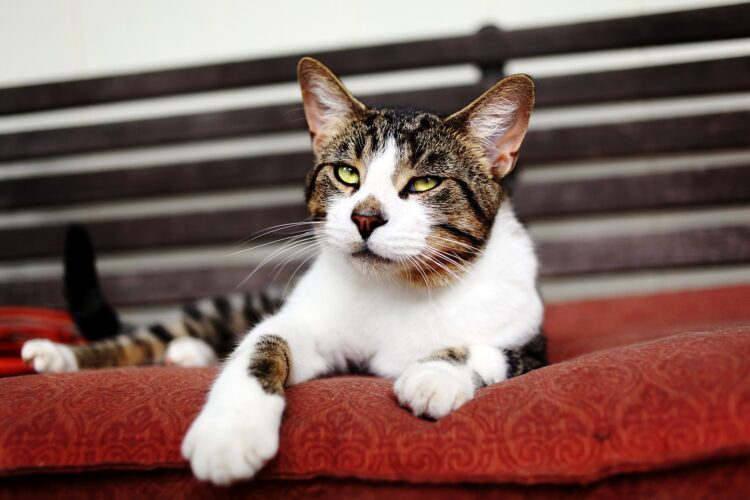
This post contains affilaite links*
I worked in various veterinary clinics for over twelve years, and during those years, I met some pretty amazing cats and dogs. The memories of some of these animals, as well as the lessons they taught, have stuck with me over the years, and I thought it was time to share some of their stories. I’m calling the series “Adventures in Veterinary Medicine,” because for me, that’s what my journey in this wonderful profession was – a never-ending adventure. No two days were ever alike, just like no two animals were ever the same. In this first installment in our Adventures in Veterinary Medicine series, meet Beast.
Beast was a big bruiser of a cat. He was a brown and white tabby with a huge head, giant paws – and caution stickers all over his veterinary record. Most veterinary clinics won’t actually write “beware of cat” or “killer cat” in their records. Instead, they use a sticker system to indicate whether an animal may be challenging to work with, aggressive, fearful, a biter – you get the idea. Beast’s chart had the highest number of stickers I’d seen in any of our charts.
Beasts owners traveled quite a bit, and since Beast had some urinary tract issues, they were not comfortable leaving him at home with a pet sitter, so they boarded him at the clinic with us. Beast hated being confined in a cage. But even more than being in a cage, he hated it when anyone so much as approached his cage, and he made his displeasure known by hissing, growling and throwing himself at the cage’s door. It made taking care of him challenging, to say the least, but we did the best we could, and usually, we’d let our most experienced technicians, our “cat wranglers,” deal with him. But on weekends, whoever had kennel duty had to find a way to clean out Beast’s cage, give him fresh food and water, and change his litterbox. At the time, I worked a lot of weekends as a kennel attendant, so the odds were good that I would have to deal with Beast at some point.
I had been trained in safe and proper feline restraint techniques – techniques that made handling safe for both the cat being handled, and for the person handling the cat. But I’d never had to work with a fractious cat without another person to help me. Rather than using the restraint techniques I had been taught, I decided to try a different approach. I completely ignored Beast’s posturing, hissing and growling while I took care of the other animals in the kennel. Whenever I passed his cage, I quietly talked to him, but never acknowledged his aggressive behavior.
When I had taken care of everyone else, I walked back to Beast’s cage and just stood and quietly talked to him for a while. And much to my delight, he calmed down, and just sat at the front of the cage watching me with a puzzled expression on his face. Why wasn’t I afraid of him? Why didn’t I cower in fear like all the other people he’d so successfully scared off? Eventually I slowly unlatched the door to his cage and opened it slightly. Beast didn’t react. No hissing, growling, or lunging. What I felt coming from him, more than anything, was curiosity. I slowly opened the cage door wider, talking to him all the while. He stood up. I remained calm, trying very hard not to flinch.
What happened next is not something I could have predicted in my wildest dreams. This big cat, who had terrorized our entire staff, put his paws on my shoulders, buried his face in the crook of my neck, and started a rumbling purr. He rubbed his face against mine, never once letting go of his “hug” around my shoulders.
I was eventually able to pick him up and move him to an empty cage while I cleaned his cage and gave him fresh food, water and a clean litter box. I was able to put him back in his cage without any fuss. He kept rubbing up against the front of the cage even after I had closed the door, purring all the while. The Beast had been tamed.
He was never this calm with any of the other staff members after this experience, but he also wasn’t as aggressive anymore. I often wondered what changed for him that day. Was it that someone didn’t expect him to be aggressive, so he didn’t act aggressive? Had he just finally reached a point where he was so starved for human affection after a few days at the clinic that he realized how counterproductive his behavior was?
Things aren’t always what they seem. A fractious, aggressive cat may simply be starved for attention. A big, intimidating tom with a name that is meant to inspire fear may be a great big teddy bear. The lesson for me in this story was to trust my instincts. It may not have been the smartest choice on a rational level, but it felt like the right thing to do. Intuition never lies.

Adventures in Veterinary Medicine is available from Amazon.
*Purrs of Wisdom is a participant in the Amazon Services LLC Associates Program, an affiliate advertising program designed to provide a means for us to earn fees by linking to Amazon.com and affiliated sites. This means that if you decide to purchase through any of our links, we get a small commission. We only spread the word about products and services we’ve either used or would use ourselves.








Super story……a real lesson in bringing calm to a cat who was so used to being feared and feeling fear from others that he was simply thrilled to be around a calm, cool, and collected human! I try to do the same when I’m around an unfamiliar cat – gentle voice, getting down on their level, etc. It’s so true that most often kindness begets kindness.
This is how I seem to approach any cat whether known a little or a lot… I try to approach with nothing but and acceptance. If they want to scratch or bite I know it is fear that drives them and not so much anger. Don’t get me wrong I don’t want them to but if they do it wasn’t intentional. I accept them and if I approach this way they seem to do the same towards me.
Beautifully stated, Ronda.
Bernadette-what a nice thing to say. I wish I were closer, too.
Ingrid-It’s one of your gifts-taking time.
~R
What a wonderful story! I love hearing about scared or “mean” animals coming around and being loving! I had a stray who I called Melvin that wouldn’t let anyone but me touch him. He became quite loving with me though! A victory like yours with Beast!
I like this new series from you the ultimate “cat wrangler”.
I’m glad you enjoyed Beast’s story, Marge.
ihavecats, I never met Beast’s family, but I know he was a well-loved and well cared for cat.
Daniela, I love how Gaijin distinguishes between not using her claws with you,but making sure that Crosby knows she has them and will use them if necessary!
Bernadette, I’m not sure I’d call what I did brave – in hindsight, I really think I was being somewhat irresponsbile by taking a chance like that, but something told me it was going to be okay. I absolutely think that talking to him was one of the things that calmed him down.
Debbi, this was long before I took my Reiki training, but apparently, my own energy, even then, was fairly calming and soothing to cats.
Renee, I love the term “misunderstood” in this context! I think that’s why it’s so important to connect with the energy of each individual, whether it’s an animal or a person. Like you said, it takes a little time to do this, but it’s so rewarding when we take the time to do it.
Renee, that was beautiful! I wish you were near us for the days I’m away…
Great story. We used a term regarding our more ‘difficult’ kitties: “he’s just misunderstood”. Just taking the time to look closely and really ‘see’ others and recognize them as vital and special individuals is so important. Beast is lucky to have received that from you. It can be easy to get caught up in the pace of work and life, and the presumptions that carry us through shortcuts that help to wrap up the day’s lists and responsibilities. So much opportunity is missed to see the delights, vulnerabilities, needs, and gifts that each living creature has.
Ingrid, I suspect that your calm and confident energy is what Beast picked up on. I learned that from you and dealing with my Abbey. After the Reiki, she was a new kitty
Also, in my dealings with ferals, they seem to respond to a humans tolerance of them and humans letting the cat make the first move. This really earns their trust. Most of my ferals dont run too far from me now. It’s very rewarding to watch the change in their reaction to me when I approach.
You are brave! I would do this in my own home with a cat I know a little better, and I’ve caught a few frightened strays by luring them with my voice, but never a bruiser like Beast! Did you tell the staff or his people what you had done? I wonder at the reaction.
Do you think your talking to him was an important element? I’ve always talked to all my cats even from before they entered my house, not like babies but like little people, and I think it’s one of the things that’s contributed to my household of rescues becoming so social and friendly.
Wow, great story, Ingrid. Thank you for this series. I’m sure it will be very interesting!
My cat Gaijin is very nervous and fearful around some cats, and she can get really violent. She knows I step in to protect her when she is being ambushed, though.
Even though she has poor manners in terms of controlling her claws (I guess she had no other cats around to teach her that when growing up), she makes sure she doesn’t hurt me at any circumstance.
It’s very cute to see her being careful and sweet around me, while trying to make her “do not approach” statement to Crosby. I’m a proud cat mom.
🙂
What a wonderful story. I can’t wait for the next in this series! What a lovely touching moment between you to. Beast was so lucky to have encountered you…i hope his family didn’t leave him toooo much. it makes me sad when people have animals but aren’t around to be with them. i guess it’s better than being a stary?
That is a wonderful story.Good for you to tame the Beast. He was probably so glad to see someone friendly, that he just had to hug you. All my fooling with feral cats has taught me to be really patient and pretty soon they will trust you. This is going to be a fun series. Glad you are doing it.